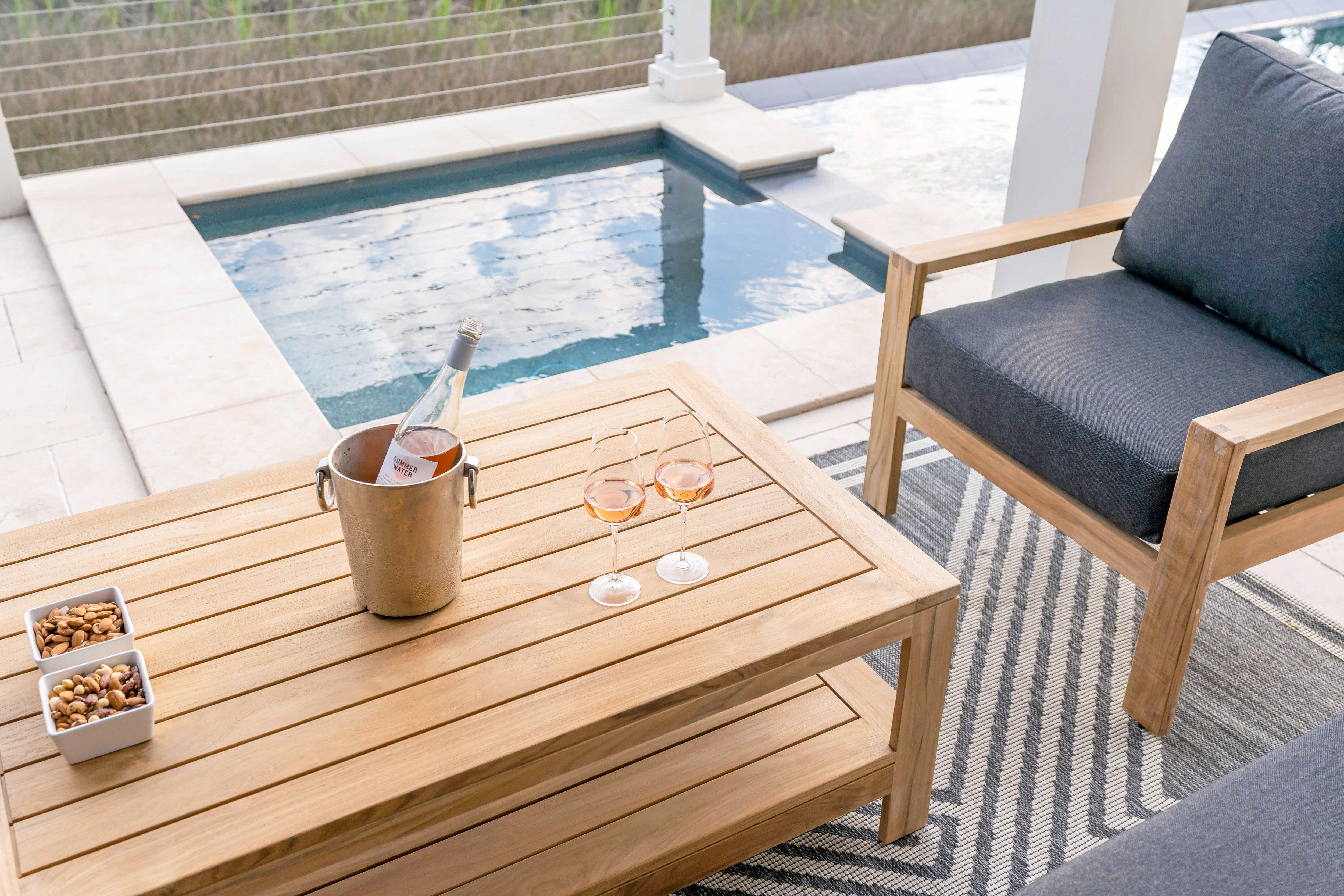Acacia and teak are two wood varieties valued for their warm brown colors, high durability, and natural oils. As a result, both wood varieties make popular materials for outdoor furniture.
That said, acacia and teak differ in several important ways. Understanding these differences is the first step in deciding between acacia vs. teak outdoor furniture.
Fortunately, we’re here to discuss the differences between acacia wood outdoor furniture and teak outdoor wood furniture. In doing so, we’ll help you find the next piece to transform your outdoor space.
Origin
Each of these different woods have a unique origin story:
- Acacia is a tree native to the Indian subcontinent, the Middle East, and some African regions. A weather-resistant tree, acacia can withstand tropical rains and desert heat. Furthermore, woodworkers and artisans cherish acacia for its eco-friendliness. Acacia can grow upwards of 30 feet in as little as five years. This growth rate means acacia can continually capture harmful greenhouse gasses.
- Teak is native to India and Southeast Asia. As a result, the teak's ability to thrive in wet, humid conditions resembles acacia. However, given teak’s abundance of natural oils, teakwood is particularly suited for rainy areas. For many years, producers highly exploited teak. Now, most teak producers control production to ensure sustainability.
Durability
Although woodworkers consider both wood varieties highly durable, teak has a clear advantage. This advantage is due to teakwood’s hardness.
According to the Janka hardness test, teak has an average hardness score of 2,330 on a 4,000-point scale. Acacia, on the other hand, can score as low as 1,100.
This difference in hardness means that while both wood varieties can withstand damage, an outdoor side table made of teak can last much longer than one built from acacia solid wood.
Weather Resistance
You may be asking: “Can patio furniture get wet?” Will acacia or teak wood warp when exposed to the elements? Both trees are native to hot, humid areas. As a result, these varieties can withstand tropical climates. That said, teak has the advantage when it comes to:
- Heat – Both teak and acacia are resistant to prolonged periods of heat. However, the teak’s higher natural oil levels prevent the wood from drying out and cracking from exposure to direct sunlight . Acacia furniture is also heat-resistant but will crack from too much heat.
- Water – Teak is much better than acacia at withstanding water damage. That’s because teak’s natural oils stop water from entering, rotting, and warping the grain. Acacia can also prevent water damage—to a degree. However, too much moisture can cause acacia to rot and warp.
Teak’s ability to resist weather damage gives it the edge over acacia. If you live in an area of salt, spume, and spray, teak is your best bet.
Color
Acacia generally sports dark, brown, cherry-toned hues. Teak, however, is generally lighter in color, radiating a deep golden brown.
When choosing between acacia and teak based on color, look at your patio’s color palette. Given that most patios receive a lot of direct sunlight, teak works especially well for outdoor areas.
Teak’s lighter shades can also make surrounding features pop. For example, a chaise lounge made from teak can emphasize a swimming pool’s deep blue hues.
Smell
You may be surprised to learn that smell can play a role in wooden furniture selection—especially when people choose between acacia and teak.
- Acacia can have a warm, honey-like smell
- Teak can smell like leather. In fact, many people value teak’s bold, woodsy aroma.
Maintenance
In addition to praising teak for its durability, people laud the variety for being low-maintenance.
Teak’s natural oils play a role in its longevity. Other than washing teak furniture with soap and water, you generally don’t have to do much to care for teak.
Acacia, however, requires a bit more care. If you buy acacia patio furniture, you may have to:
- Turn your wood furniture frequently to avoid sun exposure
- Clean up any alcohol-based spills immediately
- Regularly apply oil or wax to prevent moisture damage
Cost
Although teak and acacia are superior to most wood varieties, teak nudges past acacia in many categories. As a result, teak costs significantly more than acacia. Teak’s controlled production also plays a role in its cost. Our patio furniture buying guide gives a rundown on what to look for when buying teak, acacia, or other types of wood materials.
Acacia typically costs $10 per board foot. Teak, however, costs $50 per board foot on average.
That said, teak may be worth it in the long run. As stated above, teak packs more than sleek finishes—it’s also meant to last for decades. Teak’s longevity becomes important when choosing the best wood furniture, like outdoor dining extension tables and patio chairs. You want these pieces to delight you and your guests for years.
Perfect Your Patio with HC Luxury Outdoor
Teak and acacia wood are similar in many respects. Both can make excellent choices for outdoor patio furniture. However, given teak’s increased durability and weather resistance, teak tops acacia.
That said, even teak is only as good as the company that transforms it. For the best of the best in teak patio furniture, there’s HC Luxury Outdoor.
In addition to our stunning collection of teak chairs, lounges, ottomans, and tables, we offer next-day shipping. That means you can turn your patio into an oasis quicker than you imagined.
Welcome to HC Luxury Outdoor, your home for everyday elegance.
Sources:
Acacia Wood USA. What Is Acacia Wood? https://acaciawoodusa.com/pages/what-is-acacia-wood/
Designing Idea. Acacia Wood Vs Teak (Pros and Cons & Comparison). https://designingidea.com/acacia-wood-vs-teak/
Woodworking Trade. Teak vs Acacia Wood Difference – Pros & Cons. https://www.woodworkingtrade.com/teak-vs-acacia-wood/#:~:text=Acacia%20has%20a%20more%20striking%20wood%20grain%20pattern,and%20subtle%20finish%20to%20both%20types%20of%20wood.



